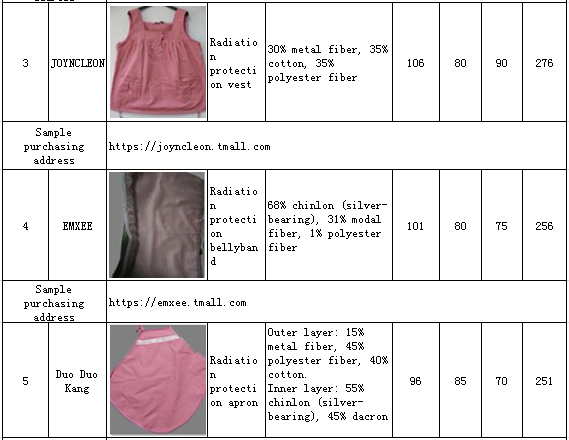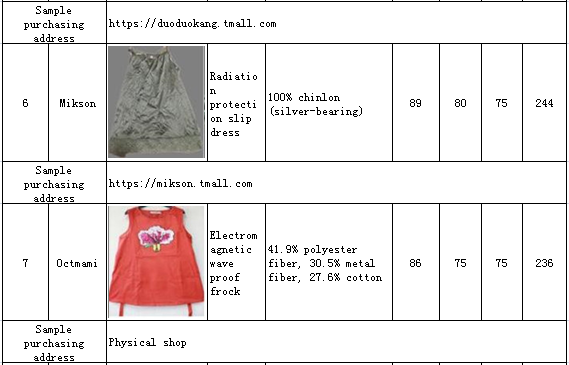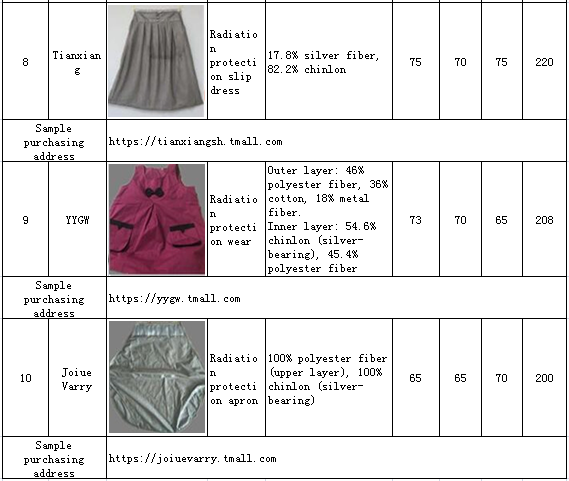|
2019 Report on Functional Comparison Test of Radiation-proof Clothes for Pregnant Women
27/02/2019
The rise of technology allows us to enjoy unexpected life experience. However, electromagnetic radiation brought by various electronic and electrical products has become a new concern. According to the ESMMC survey, more than 90% of women will purchase radiation-proof clothes when preparing themselves for pregnancy in response to the increasingly complex environment exposed to electromagnetic radiation. However, different kinds of such clothes are sold in the market and many mothers-to-be do not know how to choose user-friendly and functionally outstanding radiation-proof clothes for pregnant women. At the beginning of this year, ESMMC conducted a functional comparison test on hot-selling radiation-proof maternity clothes to provide some hints for consumers. “The current market has seen different radiation-proof maternity clothes made of different emerging materials or featured with new functions; and the price of single product is gradually rising and some merchants even promote products by bait advertising.” When it came to this test, relevant ESMMC leader said that they conducted the test to provide guidance for consumers in reasonable consumption and reminded that: “in addition to brand, price and reputation, you should also put your eyes on shielding performance, comfort, durability and composition when selecting your radiation-proof wear.” All samples used in this test were purchased by ESMMC employees as ordinary consumers from shopping malls, supermarkets and Taobao stores. Among 207 samples, 57 were purchased from traditional stores and 150 from online ones in Taobao. These samples include 79 radiation-proof pieces made of metal fiber, 103 pieces of silver fiber, 33 pieces of color silver fiber and 2 pieces of mulberry silk and silver fiber, which are manufactured and sold in the 5 provinces (cities) including Beijing, Shanghai, Guangdong, Zhejiang and Jiangxi where the main production bases in China are located, including Uadd, TianXiang, OCTmami, JoynCleon, Duo Duo Kang and other well-known brands. Given that no national standards for daily-worn radiation-proof clothes have been issued, this test was conducted with reference to GB/T 23463-2009 Protective Clothing - Protective Clothing against Microwave Radiation, using the electromagnetic frequency of 500-1000MHz and 2.45GHz respectively, basically covering the frequency range of the main electromagnetic waves found in our daily life. Due to frequently occurring power frequency alternating electromagnetic fields in daily life, this test using effective equipment also verified the shielding performance of these clothes against such fields. In GB/T 23463-2009 Protective Clothing - Protective Clothing against Microwave Radiation, the three key parts, including head, chest and lower abdomen were tested. Since the head is not covered by these samples, the test is only used to verify the shielding performance for the abdomen and chest. At the same time, the test was carried out according to ISO 9237-1995 "Textiles - Determination of Air Permeability of Fabrics". The acceptance of the human body when the fabric contacts with the human body is obtained, that is, the comfort of the radiation-proof clothing sample. The durability of radiation-proof clothing samples was tested by machine washing and hand washing. According to ISO 2910-2009 "Determination of Composition Content of Textiles and Fabrics", the component content of radiation-proof clothing samples for pregnant women was tested. I. Conclusion 1. Most samples used in daily life can effectively shield electromagnetic waves from power frequency alternating electric fields and 2.45 GHz high frequency waves. The test results showed that these samples performed well to shield power frequency alternating electric fields (50Hz) common in daily life and most of them had obvious effect on shielding 2.45GHz electromagnetic waves. 2. Under certain conditions of heat preservation, the better the air permeability is, the more comfortable you will feel when wearing such clothes. Air permeability of fabrics depends on compactness and texture. Under certain conditions of heat preservation, the better the air permeability is, the more comfortable you will feel when wearing the clothes. All four types of fabrics were tested at this time and proved to be able to meet basic needs (>5mm/s). The testing for air permeability was based on GB/T 5453-1997 Textiles-Determination of the Permeability of Fabrics to Air. Findings: Fabrics made of mulberry silk silver fibers and color silver fibers perform better in air permeability than those of metal fibers due to the fact that silver is more ductile than metallic materials and these fabrics are manufactured using advanced techniques and processes. 3. After a single wash, the samples just saw little change in their protective features. Washing has a complicated effect on clothing. On the one hand, washing may cause shrinkage of the fabrics, which may result in reduction in the coverage of a garment to our body. However, such shrinkage may also increase the compactness of fibers to enhance their shielding performance. On the other hand, excessive washing may cause the silver ions off the fabrics to fall or metal fibers to break off, resulting in poor performance in shielding electromagnetic waves. Therefore, different samples varied in shielding performance after washed. Generally, most samples featured better performance after hand washing than after machine washing, which showed that manufacturers’ advice on washing ways for consumers could help clean the clothes while ensuring their protective function. A single wash (by machine or hand) will not significantly reduce protection from electromagnetic waves. 4. Composition of all samples meets the standards. Fabric component content is an important indicator of product quality. It reflects the texture, permeability and appropriateness of the product. It is the key factor for consumers to choose and buy goods. If the labeled component content does not match the reality, it will mislead consumers. In this comparative test, the testing method of component content is mainly based on ISO 2910-2009 "Determination of Textiles and Fabrics Component Content". Testing results showed that the content of fabric components of all samples met the standard. II. ESMMC recommendations 1. Proper attitude towards electromagnetic radiation In daily life, computers, mobile phones, microwave ovens, refrigerators and other household appliances, electric lines and telecommunication base stations all will produce electromagnetic radiation more or less. At present, relevant safety standards have been issued to regulate electromagnetic waves in the environment. In China, the Controlling Limits for Electromagnetic Environment GB8702-2014 regulates electromagnetic radiation from residential occasions and daily activities, excluding occupational radiation and radio frequency and that required for microwave therapy. Therefore, in some specific space such as computer rooms, hospitals, equipment and instrument rooms and other rooms featuring intensively distributed electronic circuit, or those proved by a qualified testing organization under exposure to much more electromagnetic waves, it is recommended to wear protective clothes with excellent shielding function against such waves. The impact of electromagnetic radiation on pregnant women and fetuses depends on duration and intensity of being exposed. The electromagnetic radiation that pregnant women are exposed to mainly comes from TVs, computers, mobile phones and household appliances commonly used. Relevant national standards have been issued to control electromagnetic radiation arising from these products and ensure that conforming products are reliable and do no harm to our health. 2. Proper protection from radiation Generally speaking, electromagnetic waves on daily occasions will not exceed the limit stated in the national standards for environmental electromagnetic waves. Pregnant women who usually stay in workplaces with strong with strong electromagnetic radiation or those proved exposed to such radiation should wear protective products with good shielding effect. The test result shows that different designs of these radiation-proof clothes have different effect. In fact, electromagnetic radiation is the result of different daily occasions, not only directly from the front side. Of all designs in this test, the bellyband worked better than other designs in terms of protection from electromagnetic waves directly from the front side. However, in case of electromagnetic waves from other directions, it is recommended to wear fully covering radiation-proof clothes, such as long jumper skirts or radiation-proof garments. In addition to wearing functional radiation-proof products, all mothers-to-be should not spend much time on electronic products and equipment like TVs, computer and mobile phones and should keep an appropriate distance when using them to avoid excessive exposure to electromagnetic radiation. 3. Top 10 radiation-proof clothes in this test.
Table of contents
|
|
©ESMMC 2013 ESMMC including ESMMC Asia,ESMMC Europe,ESMMC America,ESMMC Africa,ESMMC Oceania.





